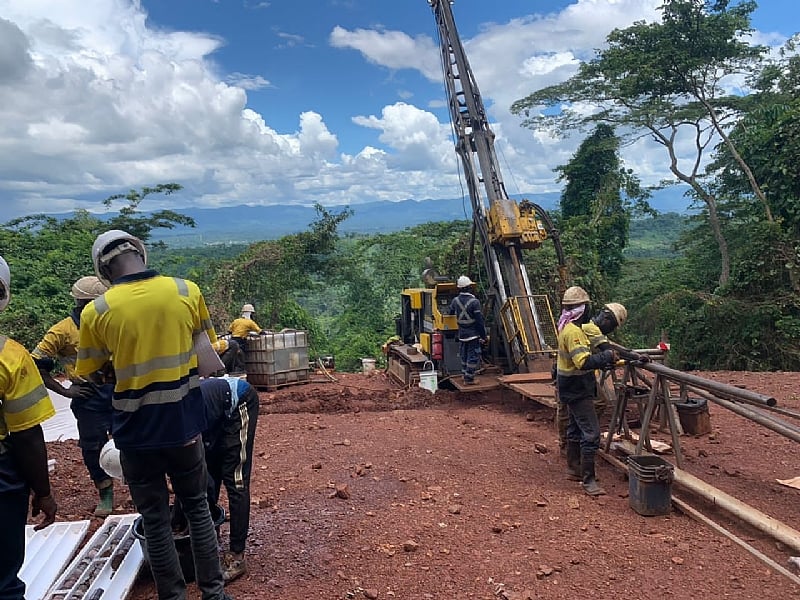The Africa Exploration and Minerals Group (AEMG), in partnership with the Ghana Integrated Iron and Steel Development Corporation (GIISDEC), is meticulously advancing the resource definition process at the Gyamonome Bloc B within the Buem Formation, located in Ghana’s Oti Region. This critical phase of mineral exploration aims to precisely determine the size, shape, grade, and location of the iron ore deposit, providing essential data for future mine planning and economic feasibility studies. Commencing in July 2024, AEMG has conducted extensive diamond drilling, accumulating a substantial 1,426.70 meters of core samples to analyze the subsurface geology and mineral content. This ongoing campaign represents a significant step forward in assessing the economic viability of the Gyamonome iron ore deposit.
The 2025 phase of exploration has witnessed a significant expansion of the drilling footprint, with twelve additional drill pads strategically positioned to enhance resource estimation accuracy. Each primary drill hole is complemented by a twin hole, a crucial quality control measure ensuring data reliability and minimizing potential errors. AEMG has prioritized minimizing environmental impact throughout the exploration process, implementing drainage control measures and site rehabilitation strategies during the construction of access routes and drill platforms. This commitment to sustainable exploration practices underscores the company’s dedication to responsible resource development.
The transition to the analytical phase began in March 2025, with core cutting and sampling procedures executed under rigorous quality assurance and quality control (QA/QC) protocols. Rock samples have been dispatched to Intertek Genalysis Laboratory in Australia, a renowned facility specializing in advanced geochemical analysis. The laboratory employs sophisticated techniques such as Inductively Coupled Plasma (ICP)-Optical Emission Spectrometry (OES) and Inductively Coupled Plasma (ICP)-Mass Spectrometry (MS) to determine the precise elemental composition of the samples. These stringent QA/QC measures, including the use of certified reference materials, blanks, and field duplicates, guarantee the accuracy and integrity of the analytical results.
Preliminary analysis conducted by the Ghana Geological Survey Authority (GGSA) using X-Ray Fluorescence (XRF) has revealed promising signs of polymetallic mineralization. Elevated levels of base metals like nickel, along with the presence of secondary minerals such as manganese, chromium, and titanium, suggest potential exploration opportunities beyond the primary iron ore target. Detailed chemical analysis of the core samples, including iron, silica, phosphorus, and sulfur content, will be crucial for guiding future metallurgical test work and developing a comprehensive resource model.
The exploration team has encountered and overcome several geological and operational challenges, including frequent drill bit wear due to abrasive lithologies and rig downtime requiring maintenance. Despite these hurdles, the team has successfully navigated complex subsurface conditions through adaptive drilling strategies, prioritizing safety, and fostering strong collaboration among field personnel. This resilience demonstrates AEMG’s commitment to overcoming technical challenges and advancing the exploration program efficiently.
AEMG maintains an unwavering commitment to Health, Safety, and Environmental (HSE) standards. Daily safety meetings, pre-start equipment checks, and diligent site housekeeping are integral components of their operational procedures. Waste management practices, including the segregation of plastic, oil, and food waste into labeled bins, minimize the environmental footprint of the exploration activities. This commitment reflects AEMG’s dedication to responsible and sustainable resource development, prioritizing the well-being of both the environment and the local community. The progress achieved thus far underscores the significant potential of the Gyamonome Bloc B for iron ore and associated base metal mineralization. Continued core drilling, expanded sampling, and comprehensive laboratory assays will further refine the geological understanding and contribute to the development of a robust Mineral Resource Estimate (MRE), aligning with GIISDEC’s strategic objectives. AEMG emphasizes its appreciation for the collaborative support from local communities, GIISDEC, and all stakeholders, reaffirming its commitment to safe, environmentally responsible, and economically beneficial exploration.


